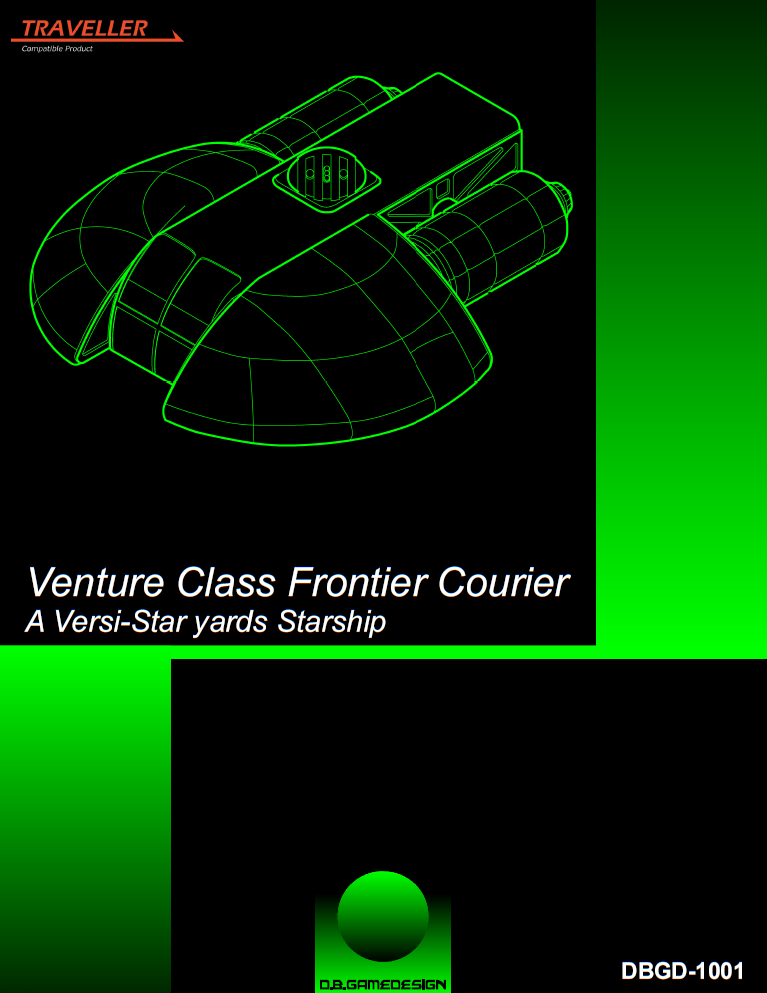Venture Class Frontier Courier
This article originally appeared in the November/December 2021 issue.
 Venture Class Frontier Courier. David Blalock & Arthur Pollard.
Venture Class Frontier Courier. David Blalock & Arthur Pollard.
DB Game Design (no website found)
12pp., PDF
US$4.00/UKŁ2.92 (PWYW)
I had hoped to like this better than I do. The diagram on the cover of this item suggested a design unlike the typical tramp trader (whether a Beowulf or an Empress Marava), which automatically made it intriguing – but on closer inspection, the design as presented doesn’t meet the specifications advertised, and the ship’s utility is questionable.
This ship is designed around the Mongoose Traveller 1st edition rules, and comparisons with the Beowulf or the Empress Marava are based on the presentations in the Core Rulebook for that edition.
The introductory summary makes the Venture out to be an economical modular design, allowing for easy and (presumably) inexpensive customization. However, the ‘standard configuration’ is claimed to cost MCr52 for a design built on a 150dt hull, as compared with MCr1 less for a 200dt Empress Marava of the same advertised J2/2G performance.
Some of the detail suggests that some of the ‘economy’ was achieved by ‘cutting corners’ rather than truly finding less-expensive and/or more-efficient parts and designs – for example, modular control panels and displays must be replaced on a regular basis because of corrosion, and some components of the drive/power-plant complex are doing double duty, meaning that if they fail, they take down two systems instead of one. Other detail offers suggestions for ‘stretching’ the ship’s operational window.
Beyond that, there are some design flaws – for example, the fuel tankage is separated from the drives and powerplant by the cargo area, and the engineering section – two pods attached to the outside of the ship – appear to block external access to the airlock that would normally allow passengers to board, leaving the only true access to the ship being through the cargo holds.
There is a specification sheet for the ship included, showing the breakdown of the construction cost by component. This gives the ‘bottom line’ as only MCr39, but by the Mongoose 1st edition rules as written, the fitted components only give Jump 1 and 1G maneuver, not the advertised J2/2G, although the fuel capacity would in fact allow two J1s without needing refuelling, if the suggestions for ‘stretching’ the operational window can add a week to the ship’s duration. The Beowulf, with similar performance, and converting 20dt of cargo to extra fuel (to give the second J1) costs MCr36˝ and still has a higher cargo capacity. The “Commercial Efficiency Ratio” based on Ken Pick’s calculation for the advertised performance and price is 2.28 (vs 3.38 for an Empress Marava), but for the actual performance and price the CER is only 1.51 (vs 3.33 for a stock Beowulf, or 2.79 for a Beowulf modified for the extra J1) – either way, the Venture needs a subsidy to survive.
Ignoring the design flaws of the ship itself – which, honestly, really can’t be ignored – this document could have stood having a proofreader look at it; there are several grammatical errors that are jarring when you read them. Additionally, while a printout of this document might be reasonably readable, the choice of font and spacing doesn’t really lend itself to easy reading on anything less than a large high-resolution laptop screen; perhaps down to the size of one of Microsoft’s Surface tablets.
Overall, it’s worth exactly what you’re willing to pay for it – by definition, since it’s “pay what you want” – but I can’t in good conscience agree with the recommended price. If you do decide to get this, and you like deck plans as battle maps for miniatures, there’s a companion document that includes just the deckplan pages from this volume, sized for 25/28mm miniatures. Honestly, though, there are better ship designs out there.
 Freelance
Traveller
Freelance
Traveller